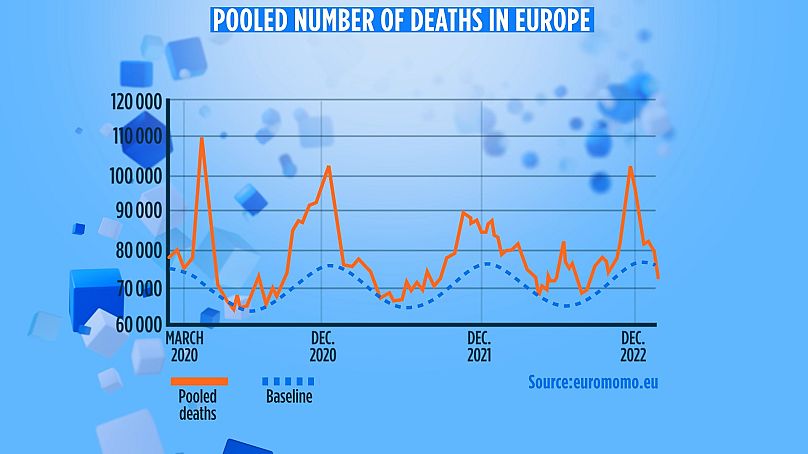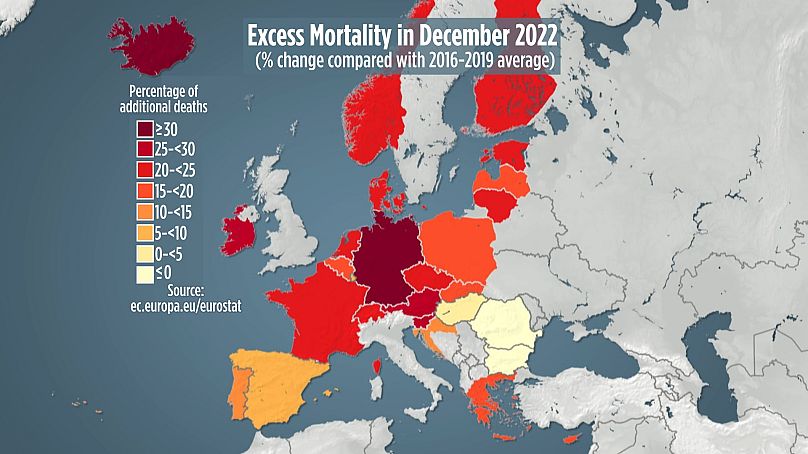As the world marks the third year since the start of the pandemic, excess deaths remain high. We asked the experts why that is.
On March 11, 2020, the World Health Organization (WHO) declared the COVID-19 outbreak COVID-19 a global pandemic. The spread of the virus led to unprecedented changes across the world, as governments and health authorities tried to curb the spread of the virus.
"In the days and weeks ahead, we expect to see the number of cases, the number of deaths, and the number of affected countries climb even higher," said Tedros Adhanom Ghebreyesus, the WHO Director-General, as he made the announcement in 2020.
Fast forward three years and statistics show that deaths caused by or related to COVID-19 significantly added to the rate of excess deaths globally. According to Johns Hopkins University, there were more than 6.8 million deaths directly due to COVID-19. But today, through vaccination and weaker mutations, the threat has been stifled.
Yet, excess mortality rates in Europe have sharply increased in recent months. We’re going to take a look at why.
What is excess mortality?
Excess mortality is the number of deaths that occur above and beyond what would be expected in a given time period. It is measured by comparing the number of deaths during a certain time period (such as a year) to the average number of deaths during that same time period in previous years.
"Mortality remains rather stable throughout the years unless something happens," Dr Quique Bassat, an expert in infectious diseases with ISGLOBAL Barcelona, told Euronews. “Deviations from the expected mortality are very useful as they act as red flags that something may be happening.”
Analysis conducted by Eurostat found that excess mortality rates across the European Union rose by 19 per cent in December 2022, compared to the average number of deaths in the same period between 2016 and 2019.
So, what does that mean in numbers? According to EuroMOMO, over 101,000 deaths were recorded in December 2022, compared to 109,000 recorded in 2020, when SARS-COV-2 was in high circulation in Europe.
But not every death with COVID-19 is a death by COVID-19. Underlying health conditions are exacerbating pre-existing conditions in people, from cardiovascular to respiratory.
The excess death rate varied between individual EU member states. In December 2022, eastern European countries, such as Bulgaria and Romania, recorded rates much lower than the EU average with -6 per cent to -5.5 per cent respectively.
But countries such as Germany, France, Austria and Ireland all exceeded the December 2022 average. Germany recorded a staggering 37.3 per cent increase in excess deaths for this month.
“It's possible that the population now has weaker immunity against flu compared to pre-COVID-19 years because very few people had flu over the last two years due to social distancing and mask-wearing,” says Dmitry Kobak, a research assistant at the University of Tübingen.
Overstrained health services
Other factors may also be contributing to the increase in excess mortality rates in Europe. For example, the pandemic has disrupted healthcare systems, making it harder for people to access medical care for other conditions. This may have resulted in more deaths from non-COVID-related causes, such as heart disease or cancer.
"[Health] systems are trying to catch up on the missed diagnoses and delayed treatments caused by the pandemic, especially when health systems were overwhelmed or simply understaffed. This greatly adds to the current strain on health systems," Dr Jeffery Lazarus, Head of the Health Systems Research Group at ISGlobal Barcelona told Euronews.
What’s clear is that the pandemic’s burden on national health systems has highlighted pre-existing strains weighing on hospital and health workers. Many say they are still struggling.
Heatwaves
Medical conditions are not the only contributing factor. The climate is starting to play a greater role in people’s health. For example, the historic heatwaves that rocked Europe in the summer of 2022, when temperatures in Spain, Italy, France, and the UK consistently hit 40 degrees: the intense dry spell on the continent not only led to droughts but also deaths.
According to the WHO, over 15,000 people died as a result of the heat In Europe.
"The most vulnerable to heatwaves are typically outdoor workers, like those in agriculture and construction as well as the most elderly in society, who are already often in poor health," Lazarus said.
Different weather extremes of summer 2022 targeted the most vulnerable groups, such as the elderly, through heat stress, respiratory problems from polluted air, and underlying cardiovascular, and cerebrovascular diseases.
What can governments do to prevent future pandemics?
The increased rates of excess mortality that we're currently seeing in Europe, therefore, are due to a number of factors.
As we start to think about a post-pandemic era, governments are acutely aware that our health and freedom are not to be taken for granted. But what can be done?
"Governments need to be proactive and not reactive," Dr Lazarus says.
"They need to follow evidence-based control measures like improving indoor air quality and promoting the COVID-19 vaccine booster. Instead, they are trying to turn the page on the pandemic, with the results that millions of Europeans are sick with COVID-19 or long COVID".


















